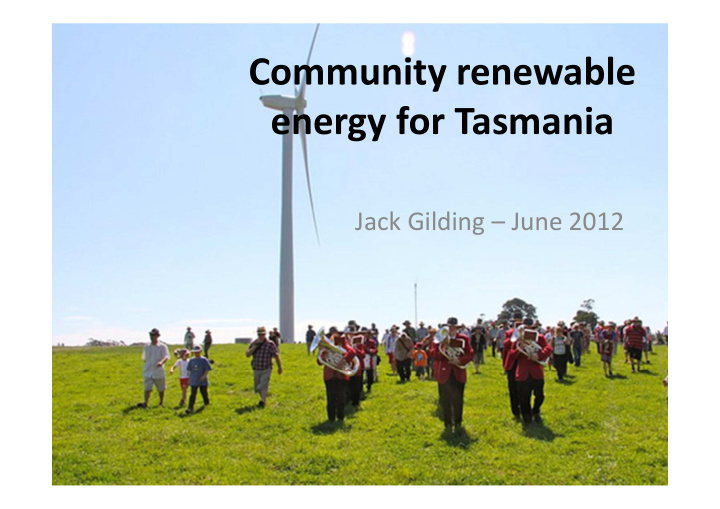



Community renewable energy for Tasmania Jack Gilding – June 2012
Overview • The Hepburn Wind experience • The potential for community energy • Tasmania’s competitive advantages • Challenges for community energy • Support mechanisms
Hepburn Wind • Scaled to local area: 2 turbines, 4.1 MW total • Co-operative model • 1900+ members raised $9.7 m • $13.5 m project • Wholesale and retail arrangements with Red Energy • Created 3 jobs + upskilled many locals • 25 year sustainability dialogue
Success factors • Community engagement • Stubbornness / commitment • Developer support (FE) • Government support (SV) • Professionalism • board members and staff
Lessons learnt • Dynamics of fund-raising • seed capital • risk and reward stages • Administrative support • moving beyond volunteer capacity • Grid connection • need early professional advice
The potential of community energy • Community action the origin of the modern wind industry – Twindkraft 1978 • In 2000, individual and community owned wind turbines 84% of Danish wind power capacity • Embark submission 2009: government investment of $100m could support the development of 100 CRE projects over 10 years.
Benefits of community renewable energy • Taps the energy and enthusiasm of communities • Demonstrates grass roots action on climate change • Creates sense of pride in ownership • Provides an avenue for education about energy issues
Economic benefits of community renewable energy • Taps sources of capital not available to commercial projects • Provides local economic development opportunities in rural communities • Greater local retention of benefits • Can develop energy resources that are viable but too small for utility scale development • Grid benefits of embedded generation
Tasmania’s competitive advantages • Physical potential for renewable energy – wind, hydro, solar, biomass, wave, tidal • Supportive government policies – Tasmanian Renewable Energy Industry Development Board – Economic Development Plan • Skills base – State owned enterprises, Hydro, Entura, Aurora – Small and medium scale businesses and consultancies • Existing projects – King and Flinders Islands, Platypus hydro, Glenorchy landfill gas • Potential as an exporter of renewable energy via Basslink – Builds on Tasmania’s ‘clean green’ image
Challenges for the development of CRE • Grid connection costs and uncertainties • Energy sales issues (PPA, feed in tariffs, etc) • Choice of appropriate organisational and financial structures • Regulatory issues (eg planning) • Economic externalities
Support mechanisms • Embark • Emergence of a national sector • Tasmanian support project
Embark • Founded out of the Hepburn experience • Supporting the community energy sector • Extensive advice and case studies • Creating positive local examples www.embark.com.au
Emergence of a national sector • Diverse projects – Wind: Mt Alexander Wind, New England, Freemantle – Warburton hydro – Canberra community solar – Yarra ranges solar • Established Google group for info sharing • Planning national conference and advocacy organisation
Tasmanian support project • Being developed by pitt&sherry • 12 months project – collaboration with other agencies • state and local government, regional bodies, state owned enterprises, entrepreneurs, UTas – awareness raising through publicity, public presentations, regional workshops – identification and support of at least three community projects and development of business cases – action research and advice on key issues and barriers
more information Jack Gilding www.backroad.com.au jack.gilding@backroad.com.au (0407) 486-651 www.embark.com.au
Recommend
More recommend